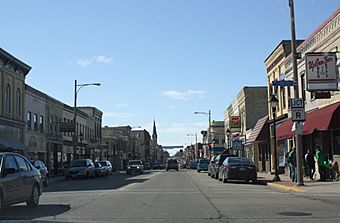Main Street Commercial Historic District (Watertown, Wisconsin) facts for kids
Quick facts for kids |
|
|
Main Street Commercial Historic District
|
|

A portion of the district.
|
|
| Location | Roughly Main St. from N. Washington St. to S. Seventh St., Watertown, Wisconsin |
|---|---|
| Area | 29 acres (12 ha) |
| NRHP reference No. | 89000483 |
| Added to NRHP | June 2, 1989 |
The Main Street Commercial Historic District is located in Watertown, Wisconsin. It's a special area in the city where many old and important buildings are protected because of their history and unique architecture. This district helps us remember what the town looked like long ago and how it grew.
Contents
What is the Main Street Historic District?
Imagine stepping back in time! The Main Street Commercial Historic District in Watertown, Wisconsin is like a living museum. It's the old downtown area of Watertown, filled with buildings that tell stories of the past. This district was officially recognized as a historic place on June 2, 1989.
It covers about 29 acres and includes 127 buildings that are considered "contributing properties." This means these buildings are important to the district's history and character. They show us how people lived, worked, and shopped in Watertown many years ago.
Historic Buildings You Can See
The district is home to many fascinating buildings, each with its own story and style. These buildings showcase different types of architecture that were popular in the past.
The Oldest Buildings
Some of the oldest buildings in the district date back to the 1850s.
- The Johnson Drug Store was built in 1855. It's an example of Commercial vernacular architecture, which means it was built in a practical, local style common for businesses at the time.
- The Dennis Block, also from 1855, shows off the Italianate style. This style often features tall, narrow windows and decorative details.
- The Misegades Wagon Works, built in 1858, is another Italianate building. It was once a place where wagons were made, which was a very important business before cars became common!
Unique Architectural Styles
As the town grew, new architectural styles became popular.
- The Platz and Brandt dry goods Store was built in 1876. It combines elements of the Queen Anne and Romanesque styles. Queen Anne buildings often have decorative textures and towers, while Romanesque Revival uses rounded arches and sturdy stone.
- The Public Library, built in 1907, is a beautiful example of Neoclassical architecture. This style looks back to ancient Greek and Roman designs, often featuring grand columns and symmetrical shapes.
The Masonic Temple
One special building in the district is the Masonic Temple, built in 1906. It's also known as the Fischer Department Store. This building has served different purposes over the years, showing how the district has changed and adapted while keeping its historic charm.

